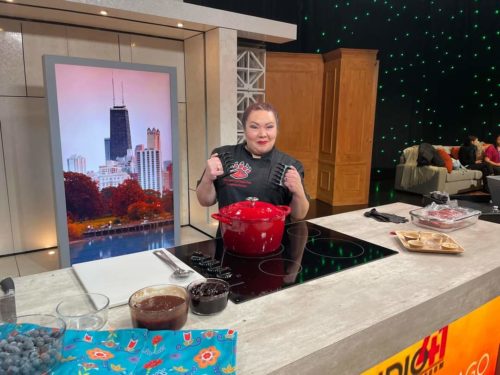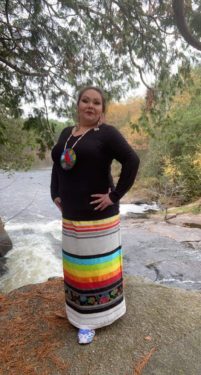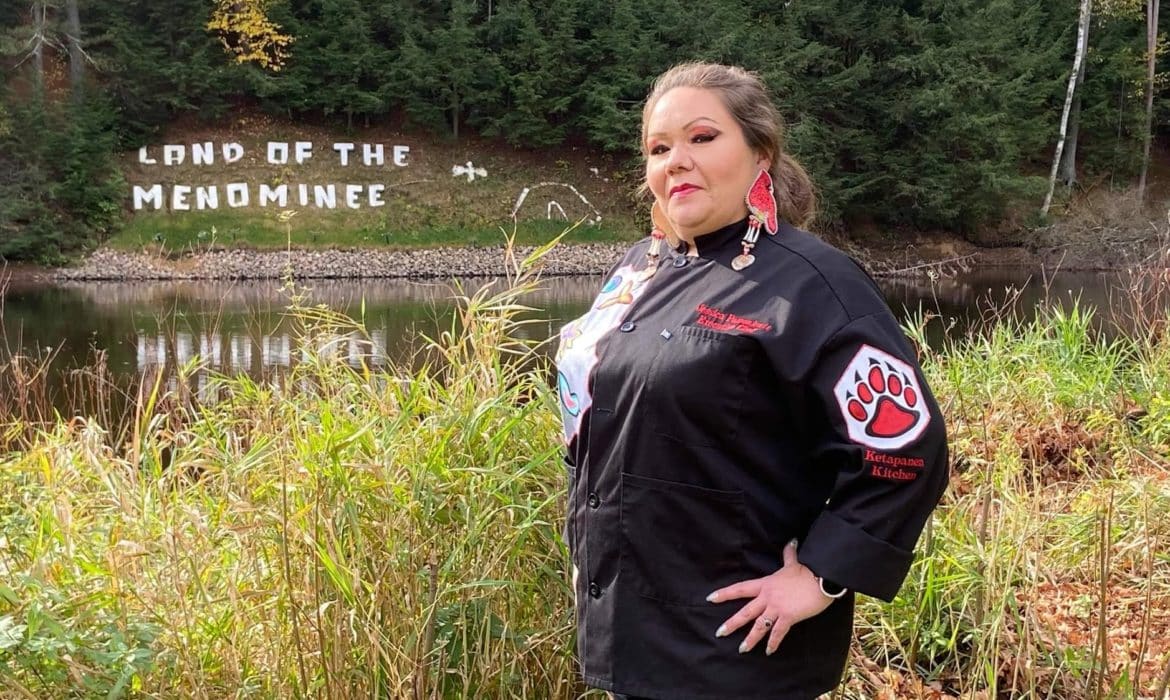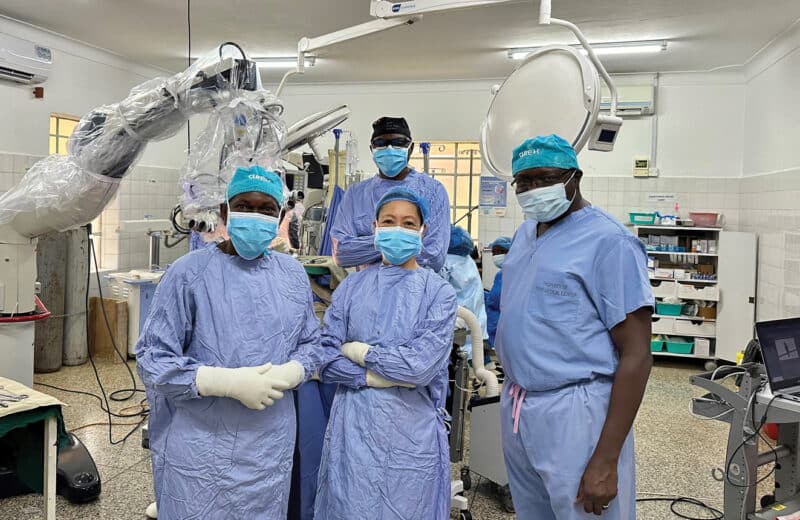Trailblazing chef Jessica Walks First is reclaiming healthy Native American culinary traditions
Jessica Walks First was feeling tired one day in early November — exhausted actually, but inspired to be doing work she felt called to do. November is Native American Heritage Month, and Walks First, a Menominee chef, had been in high demand.
As executive chef and founder of the Chicago-based Ketapanen Kitchen — a pop-up kitchen and catering service — she had just driven 500 miles to pick up 60 pounds of wild rice. She needed it to make one of her favorite recipes, which incorporates maple syrup, wild berries, and nuts into cooked wild rice. It’s one in a menu of dishes that Walks First created to “enrich our lands and lives.”

She’s finding an audience for the dish in Chicago. Chicago has the country’s third-largest American Indian population, with more than 65,000 Native Americans in the greater metropolitan area representing 175 different tribes.
Historically, Native people lived off the land and maintained natural, healthy diets. Colonization chipped away at their independence and approach to eating, in an attempt to weaken tribal power and force Natives into the new American society.
As a result, Native Americans today have some of the highest rates of chronic disease in the country. In fact, they have a greater chance than any other U.S. racial group of having diabetes, according to the Centers for Disease Control and Prevention. An estimated 16% of Native Americans have diabetes, compared to 11% of Americans at large. That 16% is likely even higher, but many people go undiagnosed because of the limited availability of health services for Native Americans, says Cynthia Gourneau, Turtle Mountain Chippewa, pharmacist, and diabetes educator at the American Indian Health Service of Chicago.
RoxAnne Lavallie-Unabia, executive director of the American Indian Health Service and a member of the Turtle Mountain Band of Chippewa, says, “Native Americans had advanced societies. The settlers and the government attempted to destroy our food and our culture, but we still exist, and we are reteaching our languages and rebuilding our cultural traditions. We are a strong and resilient people.”
Walks First is part of that rebuilding. Through Ketapanen Kitchen she prioritizes offering Native people health-conscious meals. She also educates non-Natives about Indigenous foods and sources her ingredients from Native-owned businesses and foragers, including from her own Menominee lands in northern Wisconsin.
Historic foodways
The name Menominee means people of the wild rice. “The grain used to be abundant all around the Great Lakes from the Upper Peninsula of Michigan, around Minnesota, into Wisconsin, and even down to the shores of Lake Michigan,” Walks First says. “But it is disappearing because of colonization, [land] encroachment, and climate change.”
The food remains one of Walks First’s favorites. “It is grown in water and takes on the flavor of its environment. When I eat it, it makes me feel like I’m home,” she says.
Wild rice sold in the typical grocery store doesn’t cut it, Walks First says. Machines — not people — cultivate and harvest it, altering the taste and nutrient value. For her recipes, Walks First seeks wild rice that grows in shallow, fresh water and is harvested by hand using a wooden stick to knock the grains into a canoe. Wild rice — the seed of a marsh grass — is low in calories and high in protein, dietary fiber, and antioxidants.
Native people of the Great Lakes region have nurtured and consumed wild rice for centuries. But when European settlers colonized the U.S., they intentionally broke up the foodways Natives had passed down from generation to generation. Settlers burned Indigenous crops and over-hunted buffalo to near-extinction.
Under the 1830 Federal Indian Removal Act, the U.S. government forced many Native tribes to relocate west of the Mississippi River. They were then confined to reservations where the federal government provided them with unhealthy rations, including lard, flour, coffee, sugar, and Spam. These food options weren’t only unfamiliar to the people, but had often gone rancid or .
“The word to highlight is ‘rations’ because it was only a portion, was never enough to feed a family, and sometimes the rations didn’t arrive on time,” LaVallie-Unabia says. “Natives would go to neighboring farms to take food because from their perspective, it was a matter of life and death. They didn’t want their children to starve to death.”
That unhealthy diet became the standard and was exacerbated in the 1970s when the federal government began distributing commodities — foods that the government purchased from agricultural surplus.
People living at or below poverty level qualify for commodities, which LaVallie-Unabia says are still available on reservations. “If you have been eating those foods your whole life, you are going to have health issues. And when you eat foods like that, you’re going to lack energy, and you’re not going to be moving as much as you should. That leads to obesity.”
As a consequence, Native Americans today suffer high incidences of many chronic diseases, including hypertension, high cholesterol, cardiac issues, kidney failure, and more.
An innovative chef

In blazing a trail to the future, Walks First is also turning back time to re-discover healthy ancestral culinary traditions. Walks First, the only female Native executive chef in the Midwest, is working to change those statistics, leading by example and encouraging other Native women to pursue healthy, traditional cooking.
She began cooking with her mother at a young age and honed her skills at Le Cordon Bleu College of Culinary Arts in Chicago. Avoiding processed and genetically-modified foods, she makes every effort to ensure that the ingredients she uses are as healthy as possible. Every week, she drives about 1,000 miles to gather organic fruits, vegetables, herbs, and grass-fed and free-range meats from tribal or Native foragers and local farms.
Bison, a very lean meat high in protein and rich in minerals and vitamins, is often on her menu, perhaps with a blueberry barbecue sauce. Nuts enhance a vegetable dish with their vitamins and minerals. Pumpkin — low in calories but high in vitamins, minerals, and antioxidants — makes its way into bread or cake balls. And berries, high in antioxidants, go into mousse or sauces.
Lavallie-Unabia says, “I have had the luxury of having a meal catered by Ketapanen. I had the rice and berry dish, which was very tasty, and I had buffalo roast. I have been eating buffalo throughout my whole life. Her buffalo roast, which was exceptional, was tender and well-prepared.”
Walks First links her passion, her name, and her family’s history. “The name was given to our family because we walked on new paths or different paths, and that’s what I am doing in Chicago,” she says. “I want to lead the way for other chefs to follow, and because Native American food is a new concept, education is an essential part of that.”
Besides educating others about ancestral ingredients and culinary techniques Walks First also has a message, inspired by her mother, to pass on to others. “She told me to prepare food with love and prayers because the expression of that energy transfers into every dish I prepare. Food doesn’t just nourish the body, it nourishes the spirit,” she says.
While Thanksgiving celebrations only last one day, Walks First says that giving thanks is embedded in the daily lives of Native Americans. “The expression of gratitude is essential,” she says. “Everything has a spirit, so we should give thanks to Mother Earth for the food that sustains us. If we take care of her, she will take care of us.”
Traditional Menominee Wild Rice & Berries
Courtesy of Ketapanen Kitchen

Ingredients
- 1 cup traditional wild rice
- 8 cups of water
- 1 pint mixed organic blueberries, raspberries, and blackberries
- 1 pint organic strawberries, sliced
- 1 cup pecans or walnuts
- 1 cup real maple syrup
Directions
1. Rinse wild rice. Add to a large pot with the 8 cups of water. Bring to a boil.
2. Once boiling, lower heat to maintain a simmer. Occasionally, I add berry juice to the water as it boils. This is optional.
3. Cook the rice until it starts puffing out. The time depends on the type of rice you use; it’s generally around 40 minutes. The longer you cook the rice, the puffier and softer it will be. If you prefer softer rice, the final dish will be closer to a pudding than a salad. I like it both ways.
4. Once the rice is cooked, strain. Add maple syrup to the rice, and mix thoroughly. Let cool. Add in your berries, and gently mix together. Sprinkle nuts on top. Chill and serve.













